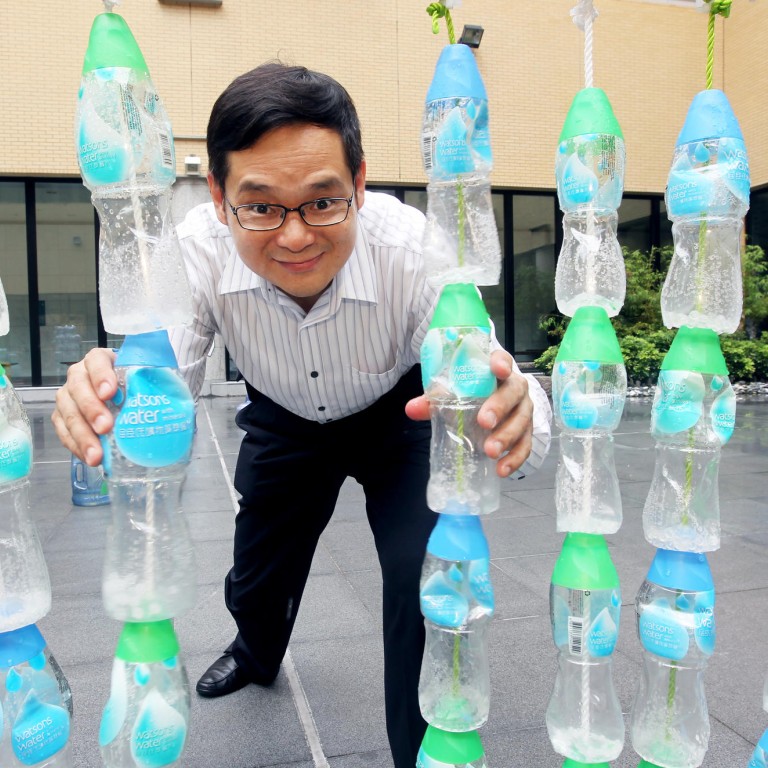
Former Hong Kong Philharmonic percussionist has an environmental approach to music
Former HK Philharmonic percussionist takes an environmental approach to making music
Standing among rows of empty water bottles, percussionist Lung Heung-wing explains how the different shapes and sizes can be arranged to produce a wide range of musical notes.
The former principal percussionist of the Hong Kong Philharmonic Orchestra is able to transform even the most humble of everyday objects into musical instruments.
You can produce musical notes spanning two octaves by using bottles
Among the materials he has used are shells strung together with fishing line, and cardboard boxes, which he fashioned into a drum kit. "Although there are between 50 and 60 types of percussion instrument in an orchestra, an infinite number of materials can be used to make one," he says.
Lung's boundless creativity is on display in the "Intelligence Infinity - Inspiration Through Art" exhibition at the Hong Kong Heritage Museum in Sha Tin.
He has set up a corner of the exhibition space to teach children about music by playing his whimsical creations. Three bowls and a plastic cup have been used to imitate an Afro-Cuban bongo drum. A washing board becomes a Cuban guiro. Other recycled materials include traffic cones, pans and spanners.
Lung says he came up with the idea of using discarded materials in 2003 when he set up the Hong Kong Percussion Centre, after serving as the Hong Kong Philharmonic's principal percussionist for 19 years.
"I left the orchestra and rented an office. There were no water coolers so we drank bottled water. Heaps of empty bottles were stored in the office. Then I discovered you can produce musical notes spanning two octaves by using bottles of different sizes and removing the caps from some bottles.
"I was invited to schools and charity groups to perform for students and disabled people. When I arranged these performances, I also wanted to get a message across to the students," he says.
"I later designed percussion summer courses for parents and their children at the centre. I taught them how to make instruments from recycled objects and play green-themed music. The courses are popular."
Musical training with green elements forms a big part of Lung's educational work. Last year, he conducted a series of workshops in the Space Museum and the History Museum, where primary and secondary students learned to play percussion music using discarded objects.
"In the workshops, I played a video of the extraordinary work done by Canadian band Scrap-Arts-Music. The troupe is based in Vancouver and consists of five talented musicians led by percussionist Gregory Kozak.
"They make futuristic, sculptural instruments from discarded industrial scrap found in a shipyard. They even have tradesmen's licences for metal welding. Compared to them, what I am doing is at best amateurish," he adds.
The ensemble visited Hong Kong and held a workshop at Kwai Tsing Theatre last year, Lung says. He joined the workshop and was inspired by their work. Likewise he hopes his own workshops encourage students to care about the environment.
"Students now have everything they want. They're always buying toys, even though they have heaps at home. Instead of throwing the old toys away, they should donate them to other children who are less fortunate.
"They should also know that what they consider to be rubbish can easily be put to other uses," he says.
Lung says he and his wife, a piano teacher at the Academy for Performing Arts, were introduced to green practices by their son Mark, 23, when he was a small child.
"He has more green sense than us," Lung says.
"When he was in primary school, he put paper bags all over the house and asked us to sort rubbish for recycling. He writes on both sides of a piece of paper and always uses his own bags when shopping."
Making percussion music using everyday household objects is a favourite pastime of both Lung and his son.
"Toilet pumps are used to mimic the bubbling sounds of fish. Red beans are shaken in pots. Newspapers are shredded to make other sounds," he says. Besides playing music at home, the duo has staged public performances with the Hong Kong Philharmonic. "From the age of 10, he followed me and the orchestra around the world. The orchestra specifically set aside a solo spot for the two of us. He enjoyed those public performances.
In 2010, the Hong Kong Percussion Centre was invited to stage a performance at the Shanghai Expo, Lung says. "I took along my son and 10 students from the centre. Besides mainstream percussion instruments like cymbals and snare drums, I took along instruments made from scrap. On the night before the performance, we worked until 2am to assemble an instrument in the shape of a robot. We even went scavenging for cardboard boxes in rubbish dumps.
"The audience had never seen a performance like it. They really enjoyed it, and made music with us in an interactive session. I want my son, and my students, to know that you can create beautiful music with your imagination through such performances," he says.
Lung says he used the home music sessions to distract his son - who is studying business management at University of Hong Kong, and plays percussion and piano - from the effects of a severe food allergy he suffered throughout childhood.
"My wife and I suffer from asthma, and he inherited the allergy. His body was weak when he was young. If he ingests the tiniest amount of MSG, it triggers a severe eczema flare-up and rashes all over his body.
"He is allergic to many types of food. We tried music therapy on him, and we made all kinds of quirky sounds at home to distract him from the eczema and bitter medicine," he adds.
Intelligence Infinity - Inspiration Through Art runs until Sept 23 at the Hong Kong Heritage Museum in Sha Tin

